Hoya Australis is a member of the Apocynaceae family which consists of over 200 tropical and subtropical species. A native to Australia it is commonly known as the Waxflower, or Waxvine, Porcelain Flower and Honey Plant, because of its waxy leaf texture and its honey-sweet fragrance. A popular low-maintenance houseplant that brings a touch of the tropics to your home.

What to Know About the Hoya Australis
Hoya Australis is a succulent climbing evergreen plant that can grow up to 20 feet (6 meters) in length. The plant has long, slender stems that are covered with thick, waxy leaves. The leaves are oval-shaped, dark green in color, and have prominent veins.

Hoya Australis can produce small clusters of white or pink star-shaped flowers. A native to Australia, this climbing vine is a perfect plant for beginners given its forgiving nature and low-maintenance needs and adaptability, and its high tolerance for neglect.
Hoya Australis is easily propagated and cared for making it an ideal choice to add to your house plant collection. It will add color variations during its early growth stages as the immature leaves go from a red hue to their mature deep green color, and small clusters of flowers will present themselves in late summer or early fall.
Hoya Australis is a bright light lover, and it responds well to the early morning sun and enjoys an occasional bask in the sun in the late afternoon. Other than that, just indirect and dappled light will keep this succulent happy.
The Australis is only a bit fussy when it comes to watering, as it's more likely to survive drought conditions over getting over-watered. Just remember it should be allowed to dry between waterings.
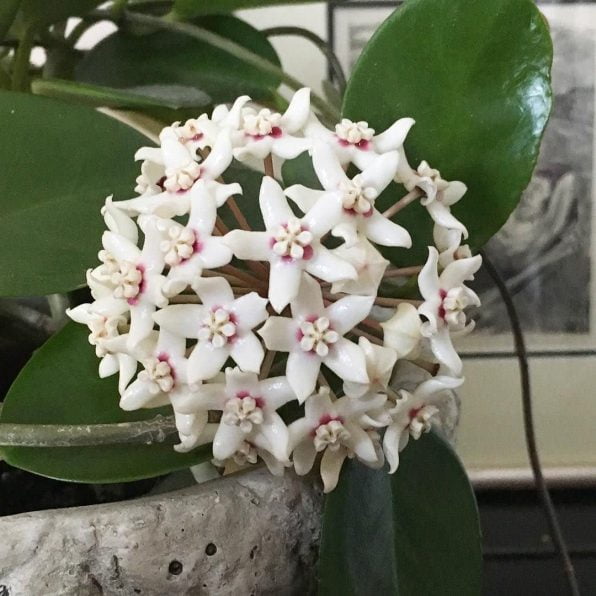
Hoya Australis Plant Basics:
| Common Name: | Wax vine, Porcelain Flower, Wax flower, and Honey plant. |
| Botanical Name: | Hoya Australis |
| Plant Type: | Flowering Succulent |
| Size: | In the wild up to 30ft, indoors around 10 ft |
| Light: | Bright indirect light, morning or evening sun can help with blooming |
| Soil: | Light loose soil, well-draining potting mix, a mixture with organic compost |
| Water: | Easily over=watered, wait to water when the top 2-3 inches are dry |
| Vulnerabilities: | Over-watering causes root fungus issues, typical houseplant pest issues, mealybugs and spider mites |
| USDA Growing Zones: | 10a – 11b |
Hoya Australis Plant Care Made Easy
Hoya Australis is a relatively low-maintenance plant, making it a great choice for those who are new to houseplants or someone who wants an easy-to-care-for indoor plant. However, like all plants, it still requires some care and attention, so in this section, we will provide some tips on Hoya Australis plant care and what to look out for, and how to enjoy it to its fullest.
What type of soil should I use?
Hoya Australis plants prefer well-draining soil that is rich in organic matter. A good potting mix for Hoya Australis would be a mix that is loose and airy, and allows for good water drainage, all the while retaining enough moisture to keep the roots hydrated.
You can use a commercial potting mix and add perlite, coarse sand, or orchid bark to improve drainage and add peat moss or coconut coir to the potting mix to retain moisture.

Try adding organic compost or worm castings as a top dressing to improve the fertility of the soil as well as enhancing the overall performance of your plant.
What are Hoya Australis' watering needs?
The Australis is a forgiving plant for the most part except for its watering needs. Overwatering can quickly lead to root rot with this plant. Because the Hoya has succulent leaves which take up and store water, you will only need to water your plant every couple of weeks, and possibly up to 3 weeks depending on the conditions.

A way to be sure about your plant's watering needs is to water deeply, allowing the water to drain through the bottom of your pot, and then wait until the soil dries out before watering again. In the wintertime, your Australis won't be as active and its growing cycle will slow down, during this time it will require less water.
How much light does a Hoya Australis need?
Hoya Australis prefers bright indirect light, although tolerant of early morning or late afternoon sun exposure it is susceptible to leaf burn if left in direct sunlight too long. A good location for the plant is near a window that receives filtered or dappled sunlight, or in a spot that receives bright, indirect light for several hours a day.
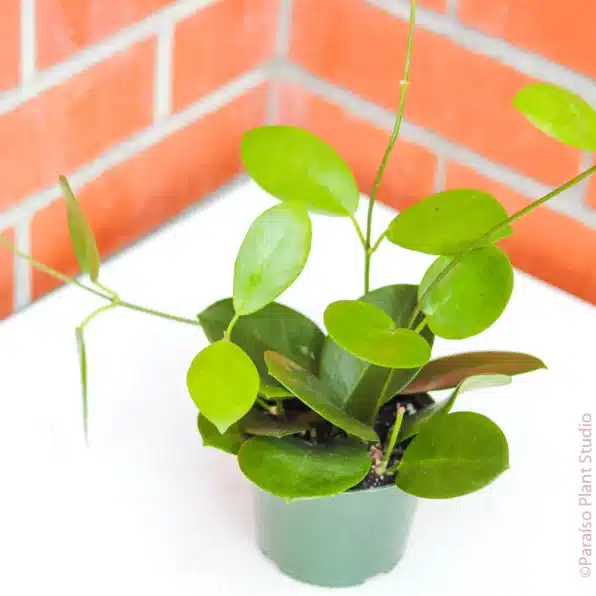
In areas with low light, artificial grow lights can be used to supplement the natural light. If the plant isn't receiving enough light, its growth may become stunted, and it may not produce flowers. This is a good plant for the office because it will thrive under fluorescent lights as well.
Finding the right balance of light is key to your plant producing flowers as well as remaining healthy and vibrantly colored.
Wax Flower Temperature & Humidity
Hoya Australis prefers moderate warm temperatures and humidity levels. The ideal temperature range for the plant is between 60-85°F (15-29°C). It can tolerate slightly cooler temperatures, but it's best to avoid exposing it to temperatures below 50°F (10°C) for extended periods of time.
Humidity should range in the 50-60% levels for optimum growth. If the air is too dry, the leaves may become brittle and develop brown tips. To increase humidity levels, you can use a humidifier, or place a tray of water near the plant. Another method is to set your pot on a gravel bed and keep the gravel moist.
Fertilizing the Hoya plant
Overall, the Waxflower is not a heavy feeder, but it can benefit from regular feedings. Diluting a liquid fertilizer or using a water-soluble fertilizer with a balanced ratio can be applied every 2-3 weeks. Be sure to follow the guidelines for the fertilizer you are using because over-fertilization can damage your plant.
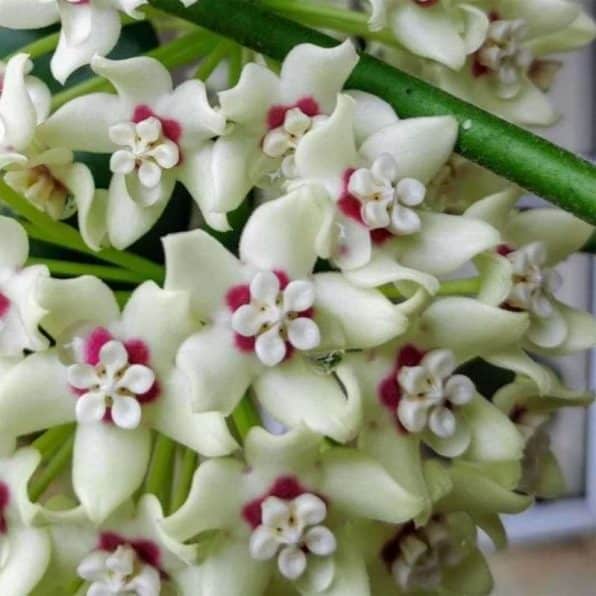
Fertilizing during the winter months is not necessary because your plant isn’t actively growing, also in the summer months if your plant is in a limited light situation and not growing much, the amount of fertilizer can be reduced here as well.
If you are propagating new plants and repotting, you need to wait at least a month before you fertilize to give the roots time to adjust and re-establish themselves.
And as an added note, it's better to fertilize your plants after they have been watered and not when they have dry soil, even if it's a liquid fertilizer.
How to prune Hoya Australis
Pruning Hoya Australis isn't really necessary and over-pruning can actually do more damage than good. So unless your plant has begun to get too leggy or has reached a point where you want to halt the growth, then it's better to allow it to grow naturally.
You can remove dead leaves, stems, or flowers and in some cases, you can pinch the vine tips to stimulate new growth and branching. When pruning, make sure you use clean, sharp pruning shears or scissors to make clean cuts and avoid damaging the stem.
How do you propagate a Hoya Australis?
To propagate a Hoya Australis take a 6-inch stem cutting in spring or summer. You can use a rooting hormone powder and plant it directly into well-draining soil. Keep the soil moist and covered and transplant your cutting to a larger pot or garden once roots have formed.
- Choose your cutting: When propagating a Hoya Australis, start by selecting a healthy stem that is at least 6 inches (15 cm) long and has a few sets of leaves. Use a clean, sharp pair of pruning shears to make a clean cut just below a node (the point where the leaves emerge from the stem). Remove the lower leaves from the cutting, leaving only the top few sets of leaves.
- Root the cutting: Dip the cut end of the stem in rooting hormone powder to encourage root growth. Plant the cutting in a well-draining potting mix, making sure to bury the node and leave the top leaves exposed.
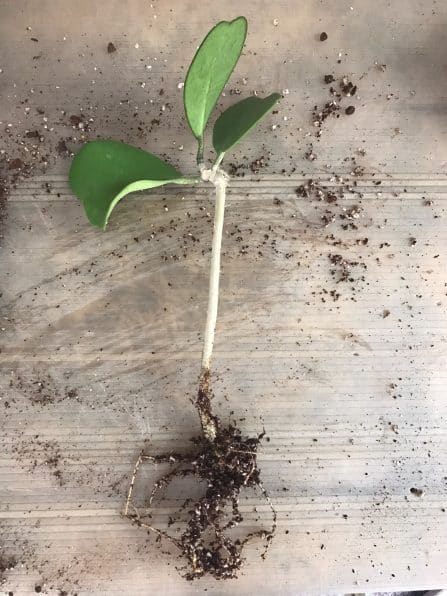
- Water the soil lightly and cover the cutting with a plastic bag to create a humid environment. Place the cutting in a warm, bright spot but out of direct sunlight.
- Care for the cutting: Check the cutting regularly to make sure the soil is moist but not waterlogged. After a few weeks, gently tug on the stem to check for root growth. If there is resistance, roots have formed, and the cutting can be acclimatized to its new environment by gradually increasing light and humidity levels. If there is no resistance, continue to care for the cutting until roots have formed.
- Transplant the cutting: Once the cutting has established roots, transplant it to a larger pot or the garden, depending on your preference. Hoya Australis prefers well-draining soil and bright, indirect light. Water the plant when the soil has dried out partially, but avoid overwatering as this can cause root rot.
- Propagation is an excellent way to increase your collection of Hoya Australis plants.
Hoya Australis Varieties
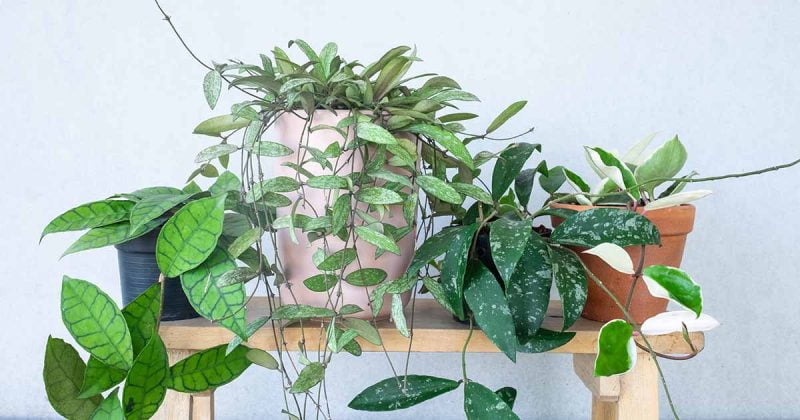
Hoya Grande: This subspecies of Hoya australis has larger leaves and slightly wavy petals on its flowers, but it shares many of the same needs as the Hoya Australis.
Hoya Kapaho: This variety of Hoya has unique rounded leaves that get larger as they grow. It prefers bright, indirect light and well-draining soil.
Hoya Oramicola: This variety has longer, narrower leaves and is slightly more drought-resistant than other Hoya australis varieties. It produces beautiful flowers and prefers bright, indirect light and well-draining soil.
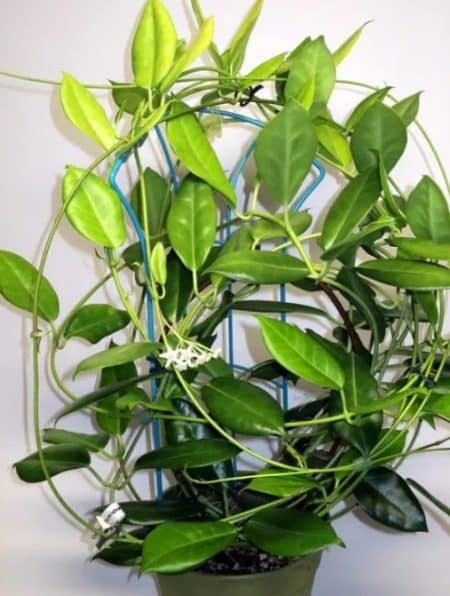
Hoya Albomarginata: This cultivar has striking lime-green and dark-green variegation on its leaves and prefers similar growing conditions to the Hoya Australis.
Hoya Lisa: Also known as Hoya Australis tenuipes, this cultivar has variegated leaves with large patches of cream that may start off pink or red and turn white and green as they mature. It prefers bright, indirect light and well-draining soil.

Hoya Carnosa: This is a popular variety of Hoya that is known for its waxy, star-shaped flowers that can range in color from pink to white. It is a climbing vine that prefers bright, indirect light and well-draining soil.
Hoya Lacunosa: This variety of Hoya is also known for its fragrant, star-shaped flowers, which are typically pink or white. It has thick, succulent leaves and prefers bright, indirect light and well-draining soil.
Hoya Kerrii: This is a unique variety of Hoya that has heart-shaped leaves and small, fragrant flowers. It is commonly grown as a houseplant and prefers bright, indirect light and well-draining soil. This variety is considered a rare variety.
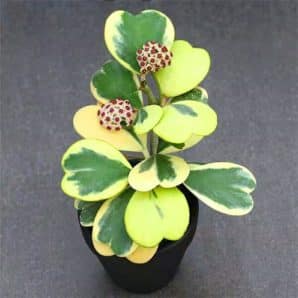
Hoya Linearis: This variety of Hoya is a trailing vine that is known for its narrow, elongated leaves and clusters of small, white flowers. It prefers bright, indirect light and well-draining soil.

Common Hoya Australis Challenges
Like most house plants, Hoya Australis can face challenges that affect its growth and health. In this section, we will explore some common challenges that gardeners may encounter when caring for this plant, along with tips on how to address them.
Growing
Growing issues can be one of the challenges you might face when choosing to grow Hoya Australis. The challenge will come down to issues with the soil, water, light, or temperature. All of these will affect the growth of the plant. Having all these in order will detour the challenges you might face.
Also, the Australis don't like change. When you move the plant or relocate to a different place it may get a bit pouty. The energy that it might have put into growing is allocated to adjusting to its new environment.
Overwatering can definitely affect the growth of your plant. Overzealous watering can result in root rot, and that will for sure affect the growth rate of the Hoya.
Another growing challenge will come when your plant enters its dormant season. Don't be tempted to water it or fertilize it into action. Let it rest.
Diseases
Generally speaking, Hoya Australis is not prone to disease, but with that comes a warning. Watering the leaves directly can cause the plant to develop leaf fungus or other blight issues. If you do mist the leaves be sure there is good ventilation to keep the air flowing.
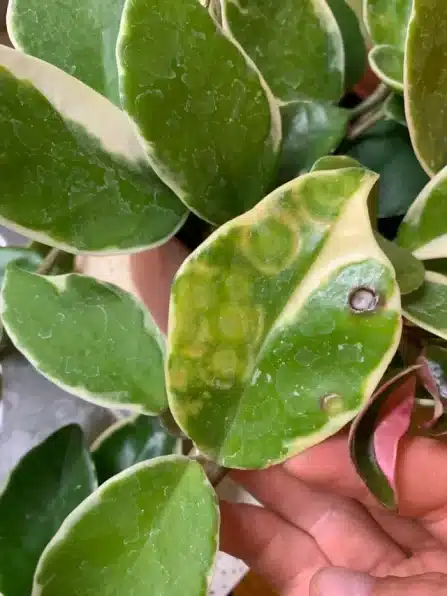
Overwatering will be the trigger in most of the issues that can challenge the Hoya Australis so be careful to allow the soil to dry completely before watering, and make sure there is airflow, and the hardiness of this plant should be enough to avoid any disease issues.
Pests
The pest that will affect the Australis is your basic house plant nuisances. Spider mites, mealy bugs, and scale insects will be what you need to look out for. These pests can cause discoloration of leaves, stunted growth, and even death of the plant if left unchecked.
Regular inspection of the plant and treating infestations promptly with insecticidal soap or other natural remedies can help control these pests. Additionally, maintaining a healthy growing environment with proper watering and fertilization can help prevent pest infestations.
Interesting Facts About the Hoya Australis
The Aroma of this popular house plant is a wonderful way to attract pollinators. Its honey-sweet fragrance and its air-purifying qualities make the Honey Plant a beautiful addition to your house plant collection. Some people think the aroma is overpowering, but butterflies love it.
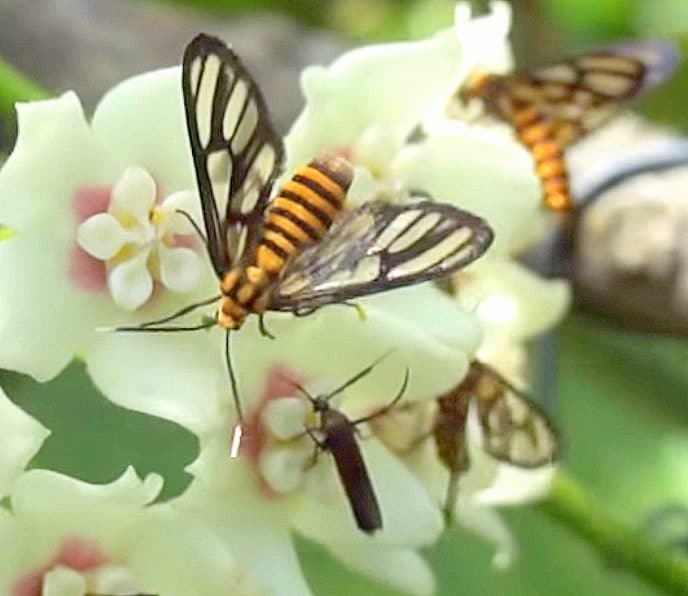
FAQs
Where does the Hoya Australis come from?
The Hoya Australis is native to Australia, where it is found growing in a variety of habitats, including rainforests, eucalyptus forests, and coastal areas. Specifically, it is found in the eastern and southeastern parts of Australia, including New South Wales, Victoria, and Queensland.
The plant has also been introduced to other parts of the world, including the United States, where it is grown as a popular houseplant. In its native habitat, the Hoya Australis can grow up to 6 meters in length and is known for its fragrant, star-shaped flowers that bloom in clusters. The plant is also an important source of nectar for pollinators such as bees and butterflies.
Are Hoya Australis plants safe for pets?
Hoya Australis plants are not toxic to dogs, cats, or horses. However, it's important to note that ingestion of any plant material can cause gastrointestinal upset in pets, such as vomiting or diarrhea.
What is a Hoya Australis Lisa?
Hoya Australis Lisa, also known as Hoya Australis ‘Tenuipes Variegata' or simply Hoya Lisa, is a cultivar of the Hoya Australis plant. It is known for its striking variegated leaves, which have large patches of cream or white mixed in with the green. The leaves of Hoya Australis Lisa may start off pink or red when they first emerge and gradually turn white and green as they mature.
This cultivar is a popular houseplant due to its attractive foliage and easy care requirements. Hoya Australis Lisa, like other cultivars of the Hoya Australis plant, produces fragrant star-shaped flowers that bloom in clusters. These flowers are typically white or pink and have a sweet fragrance.

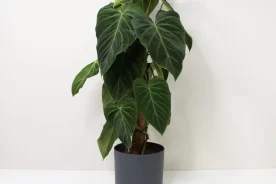

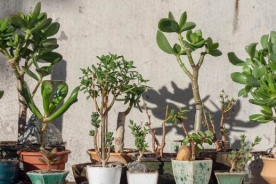

No Comments